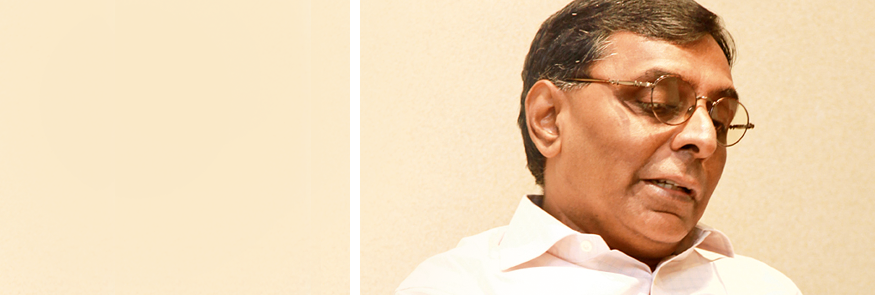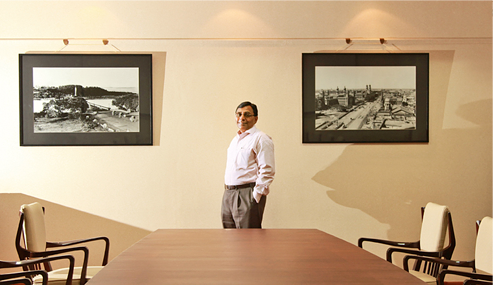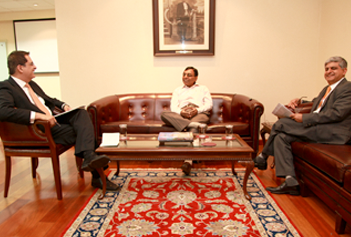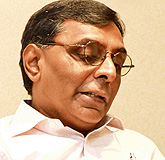“Each succeeding generation sees the family business not as a matter of ownership, but of trusteeship.”
A Vellayan on maintaining the fine balance between family interests and business success through many generations

It is often said about family businesses that ‘the first generation grows it; the second generation enjoys it; the third generation destroys it.’ Not so with the Murugappa Group. Since the founder set it up, subsequent generations have always found ways to renew it. With the fifth generation in the business and roots that stretch back to the 19th century, it is today one of India’s most respected conglomerates. A Vellayan, the current Executive Chairman, talked to The Focus about the balancing act required to build a vibrant family-owned business that has been thriving for more than a century and shows every sign of continuing to do so for generations to come.
A MURUGAPPA family photo from 1989 forcefully brings home the challenges of family and business in a way that words cannot. Taken at the 60th birthday party for MV Arunachalam, who was the third-generation leader of the business, the picture shows more than 80 members of the extended family, from white-haired elders to babies in arms. One of those pictured is A Vellayan, the son of MV Arunachalam and now the Executive Chairman of the Murugappa Group who must guide the business while taking into account the interests of generations present and to come. How does Vellayan balance the interests of so many diverse family members and renew the business from generation to generation? What about the other stakeholders – the non-family professionals, the employees, and the communities in which the Group’s companies operate?
“First of all, each succeeding generation sees the family business not as a matter of ownership, but of trusteeship,” he tells us in the Group’s headquarters in Chennai, where he sits, casually dressed, beneath a portrait of his great-grandfather, Dewan Bahadur A M Murugappa Chettiar, born in 1884.
Deeply rooted in Indian culture, trusteeship has meant using resources for the common good of family members, shareholders, and communities. In fact, ‘Dewan Bahadur,’ an official title later bestowed on the founder by the Viceroy of British India, means ‘a great man who is a steward in charge of a house of business.’
“Neither I nor any members of my generation can lay claim to establishing the idea of trusteeship,” Vellayan says. “My great-grandfather not only saw himself as a steward of the company but also supported community institutions in his home village and inculcated that ethic in succeeding generations.”
In 1898, when Dewan Bahadur was aged 14, he was sent to Burma to work as a bank clerk in a family business. Within 20 years he had built the largest private bank in lower Burma. In 1929, when his three sons were old enough to work in the business, he took the unusual step of equally dividing the family business estate while he was still alive and active in the business. It was the first in a long line of such steps that his sons and subsequent generations would take to adjust the fine balance of family members’ interests with the evolving demands of the business.
Drawing strength from outside the family
Trusteeship of the family’s interests has, over the years, increasingly meant going outside the family – for im-partial governance structures, non-family professionals, and external advisors. The company began to look outside for advice and non-family professionals during a time of rapid growth in the 1970s, but it was in the early 1990s, says Vellayan, that the business began moving decisively toward a new governance structure. “The family was growing; several of our companies were being listed on the stock exchange, and we saw a number of families that owned businesses fall apart. So we said, ‘Okay, how do we keep this together?’ We knew that unless we put in place an appropriate governance framework we would have problems as our business grew – problems attracting the right kind of partners, problems operating in an economy that was increasingly opening up, and problems making sure that family members in the business did not simply do whatever they might feel like doing.”
“We knew that unless we put in place an appropriate governance framework we would have problems as our business grew.”

At the time, a family member headed each of the seven major companies, with no overarching structure and little interaction among them. So in 1990 the family brought their disparate companies together in a more formal way, establishing a Murugappa Corporate Board, initially composed only of family members. Family members also continued as CEOs of the seven major companies, with non-family members serving as presidents.
More rebalancing was to come
Dewan Bahadur and his sons had made a far-sighted decision in the 1930s to move from looming difficulties in Burma to India, well ahead of their contemporaries. India, they believed, was on the verge of industrialization and offered greater opportunities. Since then, the business has grown and flourished through a variety of means: start-ups, acquisitions, joint ventures, diversification, public offerings, and divestitures. Greater trade liberalization, and the policy reforms that were initiated in 1991, brought with them new opportunities as well as threats, requiring the Group to be more nimble than ever before. But with individual family members committed to their separate business units and focused on day-to-day operations, it was difficult for the Group to downsize, restructure, or sell a business. It was another question of balance: personal emotions versus value creation.
“What we needed at that point was not more emotional attachment or passion for a particular business, but less emotion,” says Vellayan. “You cannot be emotionally attached to the businesses. For example, Parry Confectionery was an excellent brand, but realistically we knew that it would never be as large as Cadbury’s or Perfetti because we simply did not have the technology, so we sold it.”
In 1999 the Group separated ownership and operational management. Non-family professionals were promoted from within to become CEOs of the seven individual companies. The former family CEOs joined the newly reorganized Corporate Board, which now included three independent members from outside the family and the Group’s non-family CFO. Things then moved swiftly.
“We decided that we would consider divesting any critical business that was not number one regionally or number one or number two nationally. We concentrated on the phosphatic fertilizer business, where we are now number two nationally and number one regionally; on abrasives, where we are now number one nationally; on sugar, where we are number one regionally; on bicycles, where we are number two nationally; and abrasives, tubes, and chains, in all of which we are number one nationally. All of this was entirely by design, achieved by redirecting resources to these businesses, emotion aside.”
The new structure not only created the appropriate emotional distance between family members and individual companies, but also, says Vellayan, put new emphasis on the importance of non-family professionals.
“The core belief of the entire family is that we are here to build value, and that if we have a more independently-focused governance model and employ professionals, we stand a far better chance of creating value rather than destroying it, especially in an economic and competitive environment that grows more demanding every year,” says Vellayan.
That core belief is embodied in today’s Murugappa Corporate Board, which consists of three independent directors, three non-family executive directors, and only two family members – Vellayan and his cousin M M Murugappan. The independent directors of the Corporate Board are involved in the career planning and performance evaluation of the family members. This is done to have an objective and unbiased view.
Just as these outsiders help preserve and grow family interests, they also help safeguard the family’s values of trust, integrity, and transparency. Vellayan calls them “external conscience-keepers.” Those values are transmitted through a Family Board, headed by the karta – an elder who guides the family and who communicates the family’s views through the family member who heads the business. Traditionally, the family elder served both as karta and leader of the business, but in recent years, in another careful act of balancing, the roles have been split.
The family is also developing a Family Constitution to define the family’s roles, responsibilities, and relationships. Because written family constitutions are rare among family-controlled businesses in India, the family has looked far afield for useful examples, at one point even spending a week in Lausanne, Switzerland, exchanging ideas with other families who own businesses. Says Vellayan, “Twenty-five families came from different parts of the world; we spoke different languages, grew up in different cultures, traditions, and beliefs; but when it came to owning a family business we all faced the same problems and challenges.”
While the family has found outside models of family constitutions helpful, they are painstakingly developing a framework that they can be sure is right for them. “Our approach is to develop guiding principles, not highly restrictive rules, because as the family and the business grow you have to have the flexibility to adapt to changing circumstances,” says Vellayan. “We also want to involve all of the generations in the process, to seek their input, since it is a document that will materially affect their futures. We want them to feel a genuine sense of commitment and to derive inspiration from it, because ultimately no framework will succeed, no matter how carefully designed in the abstract, unless everyone is willing to live its spirit.”
Grooming entrepreneurs, not managers
The twice-yearly meetings of the independent directors with the family include searching conversations with the younger members in the business. In private sessions with the directors, they discuss their passions, their ambitions, and their career paths – exploring and expressing the depth of their connection to the business, not simply assuming it.
Careful grooming of young family members for the business began during the tenure of one of Dewan Bahadur’s three sons, A M M Murugappa, who held the dual role of karta and head of the business from 1949 to 1965. He prepared the males of the third generation for their future in the business by guiding their educations and having them spend time in England learning from joint-venture partners. The third generation provided similar guidance for Vellayan’s generation, making sure they had a broader education in the best national and international institutions and became fluent in all the languages – Tamil (their mother tongue), Hindi, English – necessary for operating a genuinely national business in India. Like Vellayan’s generation, male family members today are encouraged to work outside the Group during the first several years of their business careers so that they can learn and grow as ordinary employees.
Induction of a family member into the business includes careful mentoring by a trusted professional – “somebody who can make a difference,” says Vellayan. Along with a development and career plan, new entrants must also have reasonable expectations about how rapidly they can advance. Typically, if a family member enters the business at the age of 25, based on competence and capability he should aim to achieve the level of being an MD or CEO in his early 40s.
“We don’t want to make family members managers; we want to make them entrepreneurs who can recognize and seize business opportunities.”
Asked if these family members are thrust into roles carefully chosen to make them better managers, Vellayan offers a surprising answer: “We don’t want to make them managers; we want to make them entrepreneurs who can recognize and seize business opportunities, find new ways to create value, and grow the Group.”
Just as new blood entering the business helps renew it, so does mandatory retirement at age 65, which prevents, in Vellayan’s words, “an unduly long perpetuation of a single style of running the business.” If the retiree is chairman and no successor from the family is ready, then the Group is willing to appoint a non-family professional to serve as chairman, as happened in 2001.
Following the traditions of the clan from which the family comes and Hindu custom, the opportunities to work in the family business are passed only to the males. Daughters and wives provide leadership and guidance for the family’s AMM Foundation and its charitable institutions. Over the past 80 years, the Foundation has built and maintains four high schools comprising 8000 students, a polytechnic institute of 1000 students, four no-fee hospitals, and a rural research center that focuses on the development of protein-efficient algae, natural dyes, organic farming, and technologies for the rural and urban poor. These efforts often get an additional boost in leadership from the men who join in the family’s philanthropic work when they retire.
Family bonds among all members and generations are regularly renewed at family gatherings – joint vacations, retreats at one of family’s plantations, and weddings and other celebrations that take place in the family’s ancestral village.
“We recently had two weddings in our village within a month of each other,” says Vellayan, beaming – one of the grooms was his son. “Everyone in the family, even distant relatives living outside the country, come from everywhere and it’s an extraordinary bonding experience.”
Like that 1989 birthday party for Vellayan’s father, they are the kinds of celebrations that produce more family photographs, depicting more family members, more generations and – in a way that is worth a thousand words – the spirit that holds them all together.

The interview with A Vellayan in Chennai was conducted by Neeraj Sagar, Egon Zehnder, Bangalore, and Rajeev Vasudeva (right), Egon Zehnder, New Delhi.

A Vellayan
In 2009 A Vellayan became Executive Chairman of The Murugappa Group, representing a passing of the torch to the fourth generation in the family business. With more than 25 years of industrial experience managing diverse businesses, he has said that the turning point in his career came when he moved from the engineering side of the business to the Group’s fertilizer business, a sector considered unattractive at the time. Pursuing an aggressive M&A strategy, he grew the fertilizer business to become number one in the region. He is the Chairman of EID Parry (India) Limited and Coromandel International Ltd. He is also on the board of Indian Overseas Bank and Kanoria Chemicals Ltd. And he has served as a Director of the Export-Import Bank of India. Before being named Executive Chairman, he served as Vice Chairman of the Board of The Murugappa Group.
THE COMPANY THE MURUGAPPA GROUP
Headquartered in Chennai (Madras), The Murugappa Group is one of India’s leading business conglomerates, with 29 businesses and manufacturing facilities spread across 13 states in India. Its origins as a family business lie in an enterprise founded in the 1900s by Dewan Bahadur, the great-grand-father of current Executive Chairman A Vellayan. Now a market leader in such diverse areas as engineering, abrasives, finance, general insurance, cycles, sugar, farm inputs, fertilizers, and nutraceuticals, the company has more than 32,000 employees. The Group has forged strong joint venture alliances with leading international companies like Mitsui Sumitomo, Foskor, Cargill and Groupe Chimique Tunisien and become one of the fastest-growing diversified business houses in India.
PHOTOS: ADITYA KAPOOR





